#African American Arts and Culture Complex
Text
the older i get the more confused i become in regards to my identity.
#z escribe#i have been aware that i was adopted from a young age. heck i knew before my mom told me because i watched the health channel#and i rmbr they showed a skin color chart and i pieced together...two white parents don't equal a brown kid#and i thought that the colorblind mindset was a proper one to be brought up with. obviously not as i experienced racism in elementary.#and was extremely confused why 'other' white kids didn't see me as white either...well no shit you're not white baby aza#and i went through a radical phase during middle school. hating all white people. but then my mom's white fragility deterred me from that#as any time i would voice my anger she would... quite literally in tears... try to reason with me and be like ''but i'm white people...#do you hate me?'' to which i would always have to soothe her. and honestly i have become comfortable in identifying with mixed.#it is a comfortable identity because i have grown up without any specific culture (outside of american. which. how does one even begin to#define the complexities of such an identity... the way that american as a nationality transcends as it becomes a civil religion.)#anyways. i have been thinking about a guy at a party and our conversations. and how we got to our identities and i instantly...#out of habit really. told him ''well i'm half mexican or indigenous too... but i mean it's not like i'm really latin.'' and he was like.#''no azaria. you are. don't diminish yourself and your ancestors just because you weren't able to grow up around that culture''#his comment made me think about my identity once again after a long time of not wondering what it means to be Me.#and i recently submitted a paper for an internship. and god. i was reading it to my white mom. and after i read the concluding paragraph#she asked me to read it again. to which i did. and then after a pause she sighed and said i was being ''too angry''#and when i asked her to elaborate she simply said ''well it makes it sound as if white people are evil''#mind you. my application paper is about working at a museum for african american/black art preservation. like. art history is so deeply#saturated with colonialism and racism??? and she just chose to ignore that point of my paper and focus on me critiquing her fellow white#people. and to categorize me as the 'angry black person' are you Fucking kidding me. but then even with that she was like.#''i just don't get why you're so angry. you're not even black. i mean. you don't look black at all. you look mexican''#she constantly wants my identity to be simple. to be watered down. to be digestible.#i am the product of a biracial mother and fully latin/indigenous father. that is the truth of my identity. i will NEVER be perceived as#white.#but after that i just felt so incredibly shitty and called my sister and she told me what our mom said to her that day too. and i said#something along the lines of ''sometimes i feel as if mom thinks we owe her for adopting us.'' and my sister agreed.#it broke me. it really did. to know that i am not being overdramatic in my thoughts. to know that i am not simply being ungrateful.#my sister says that she copes with it by reasoning that our parents are born in the 40s and times were a lot different then. but it is hard#for me to constantly excuse their racism and ignorance towards my identity. both regarding my queerness and ethnicity.#i am so tired. so so tired.
2 notes
·
View notes
Text

COLLAGE ON VIEW
The Woods Women & Other Works
Saya Woolfalk at Leslie Tonkonow Artwork + Projects in New York, New York, USA through 23 November 2022. Saya Woolfalk creates works of art that combine elements of her African American, Japanese, and European heritage, with allusions to anthropology, feminist theory, science fiction, and Eastern religions. In this exhibition, Woolfalk introduces “The Woods Women”, a secret society that predates her Empathic Universe. The exhibition includes the artist’s newest works on paper, inspired by her study of the renowned Hudson River School and herbarium collections at The Newark Museum of Art where she was the Artist-in-Residence in 2019. MORE
*****************************
Kolaj Magazine, a full color, print magazine, exists to show how the world of collage is rich, layered, and thick with complexity. By remixing history and culture, collage artists forge new thinking. To understand collage is to reshape one's thinking of art history and redefine the canon of visual culture that informs the present.
SUBSCRIBE | CURRENT ISSUE | GET A COPY
SIGN UP TO GET EMAILS
#collage#collage art#collage artist#art#artist#art history#art project#contemporary art#artwork#art show#art books#art education#modern art#fine art#artist profile#artist book#artist portfolio#contemporary artist#artist residency#art collage#paper collage#digital collage#collage painting#collage book
3K notes
·
View notes
Note
The rapresentation of abusers in helluva boss is something that particularly frustrates me, Stella in particular, it seems to be done just to victimaze certain characters not to show the complex dynamics of those relationships. It seems to me the writers aren't mature enough to handle these topics properly.
Abuse: The Heart of Vivienne Medrano
Christmas 1962, a man renowned the western world over for his revolutionary approach to animation sat in a withering melancholy as he watched what could only be called a cinematic masterpiece based on a novel classic. Walt Disney, now in the twilight years of his life, saw the walls closing in and his legacy coming to a close. This man, who pioneered the animated feature film, saw his greatest accomplishment as his greatest obstacle. The man responsible for the tales brought to life of Cinderella, Snow White, Pinocchio, and Dumbo felt trapped in his achievement. “I wish,” Walt lamented, “I could make a picture like that.”
To Kill a Mockingbird was a piece that challenged its audience. The discussion of a white man defending a black man in southern America, decades before the civil rights movement. The movement that, at the time the movie hit cinemas, was in its infancy. Released during the height of the historically revisionist counter movement taking place to combat the rising push of African Americans towards their human rights. The last film Walt Disney ever saw the production of before his death in 1966 was The Jungle Book, a movie that was the epitome of “Safe” and a message that upheld the status quo of segregation.
It wasn’t until 1972 that the media of animation became raucously adult with those political and challenging concepts Disney felt were unattainable. Fritz the Cat was an X-rated animated film composed of vignettes that were unapologetically perverse, violent, and aggressively political. Critical of politicians and the police with a sympathetic if exploitative lens towards the LGBT and racial minority communities Brooklyn-based director Ralph Bakshi grew up around. Bakshi proved that animation was not strictly a child-friendly media and that adult animation could be financially and critically successful.
(For more on Ralph Bakshi's career and animation history)
If one has ever had the opportunity to listen to a Brad Bird (director of Ratatouille and The Incredibles) interview, it is clear to see that the success of Bakshi was generally quite limited. That animation is considered a genre and not a medium of art has resulted in animated films being knee-capped in the box office. There is far more potential to animation, highlighted by Howard Ashton in his collaboration with Disney studios during the Renaissance. Responsible for resurrecting the feature-length animated movie through The Little Mermaid and credited for the monumental success of Best Picture Award winner Beauty and the Beast, Ashton once said that the potential animation was ideal for musical theatre. The limitless possibilities given the medium gave the possibility of introducing Broadway to the common folk who didn’t live in New York and otherwise couldn’t afford the theater. He was quoted saying that live action musical films were “an exercise in stupidity,” highlighting the freedom that comes with a blank page.
However, the success of animation, and media in general, comes down to the message the media wishes to send. The reason the Disney Renaissance films have enjoyed their position as cornerstones of pop culture and creativity was because it did introduce the artform of musical theater into homes and made them readily accessible to everyone with an even heightened sense of fantasy that revitalized Walt’s ethos of making films for the child in everyone.
With Bakshi, it was the loud and violently political message of a revolution taking place. This continues in adult animation with the Simpsons, a series critical of hyper-capitalist America and the fallout of Reagan’s economic disaster that the effects of which are still being felt today and a satire of toxic masculinity and abusive family dynamics.
So, ultimately, the value of a piece of media is a cross between its social artistic influence and the message the creators are intending to make. While Medrano’s influence on the field of indie animation is often mischaracterized as a “pioneer”, the fact is that indie animation and pilots have existed and been funded before Spindlehorse existed. It is simply that Medrano has had the spotlight handed to her for the myth surrounding the production and subsequent success of his indie projects. Artistically, her influence can be summarized as a double-edged sword. For some, she is the motivation for inspiring artists to connect with the community to one day, hopefully, create their own work. On the other hand, she is the cautionary tale of why investing in an indie project is a financial risk for an audience member and a risk to the community as a whole that poses a real danger of making the indie sphere financially cannibalistic, as her public persona is off-putting to “normies” and her show is simply not good.
Much like Disney, the man in 1962, and Disney the company circa 2023, the revolution of animating "because you can" loses its luster very quickly. Without something profound to say, an entire company, regardless of its social influence, can fade into irrelevance despite still being "successful". The story of Disney is a cautionary tale for Indie animation as a whole and Spindlehorse in specific.
And that is the other axis on this chart. Her narrative lacks a message worth telling, and that’s very much due to her not having anything worthwhile to say.

“I really liked when things and shows and stories allow the characters to be flawed, and allow them to grow and to change. And I think that’s something that’s, you know, the world is not black and white. And I like things that explore the gray and that and the complexity, of life and mistakes and of things like that.” - Vivienne Medrano
It is not for want of mockery that I carefully transcribe Medrano’s words in her interview. To read the words aloud tells the story just as clearly as I have set out to do here. This is someone who is highly inspired by better media, who has ideas and a belief that she has something to say. But that is where the belief ends. There is no conclusion to that thought any more than there is one in the unfocused and run-on sentences she rambles along throughout the interview. She talks of “Things” without clarity, because she herself is a fundamentally incurious individual who has never once spent the time critically analyzing herself, let alone the work of others to better grasp what about it resonated with her. She merely consumes art insatiably and without any substance. Like a diet of fruit, it has a superficial veneer of positive value. Fruit would be considered healthy as it is “natural”. However, it is the nutritional equivalent of candy, lacking vital components that are necessary to sustain basic life, it is pure sugar. Her work, similarly, lacks any value of depth that would qualify as meaning.
Which comes back to what the message is in her work.
When it comes to others in the field of indie animation, Medrano does not have many friends. In response to the Lackadaisy situation, creator Tracy explained why she returned Medrano’s donation. For one, the donation was not Medrano’s money, but money she crowd sourced from her employees. While the $5k for the producer spot of the fundraiser would have not been a dent in her personal wallet, Medrano is so uninterested in supporting fellow creators while presenting an impression of camaraderie that she instead took money from the people she is in charge of the paychecks for to get her name in the credits of another creator’s work. In regards to why Medrano was declined her support, it was due to numerous individuals who had such an awful experience working for Medrano that they did not want her involvement associated with the project to any extent. When the money was returned, she made the situation extremely public and encouraged harassment by liking tweets attacking Tracy and the Iron Circus team.
A well-known member of Medrano’s crew, Hunter B, was leaked speaking crassly of other animation projects that were still in the process of production, met with support from other members in the discord. One of these creators being Ashley Nicoles from Far-Fetched. A former friend and creative partner on the Hazbin Pilot whose podcast streams featuring Edward Bosco and Michael Kovach single-handedly maintained interest in the show until the winter of 2021, free of charge. Ashley once spoke of how Medrano would speak disparagingly of an employee to her, saying that this individual was “Too unstable to work with”. Which, regardless of whether or not that is Medrano’s honest opinion, counts as defamation by an employer. It is the exact reason why most previous employers will not give a negative, detailed review of a former employee, maintaining instead to verify facts of the employment. If Erin Frost was more experienced and less involved in social media exposed culture, they could have easily sued Medrano and Spindlehorse for damaging their reputation in their field of employment.
Which circles back to Medrano’s self-assigned message of her show:
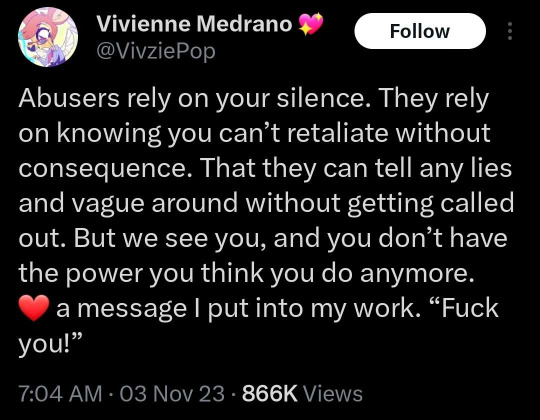
“Abusers rely on your silence. They rely on knowing you can’t retaliate without consequence. That they can tell any lies and vague around without getting called out. But we see you, and you don’t have the power you think you do anymore. A message I put into my work. “Fuck you!” - Vivienne Medrano
Medrano, who has vague and sub tweeted individuals like Lackadaisy Tracy, The Diregentlemen, Michael Kovach, and Ashley Nicoles. Medrano who has instigated and incited harassment campaigns knowing that no one can call her out without severe and relentless backlash from her cultish fanbase that she personally encourages through positive reinforcement of liking the tweets of fans. Medrano who relies on the silence of other creators in the field due to the fear of her ire collapsing their projects before they even have a chance to begin.
Vivienne Medrano with an extensive abusive history that continues to this day, has something to say about abuse.
What Medrano has to say about abuse comes from someone who has the position of superiority in all of her relationships, but feels like she’s the outcast and bullied loser. Her self insert that is repeatedly expressed in every character at one point or another is how easily they abuse those around them just because they can, but that the narrative justifies their “acting out” because they are sad. According to the National Coalition Against Domestic Violence, “An abuser externalizes the causes of their behavior. They blame their violence on circumstances.”
Indeed, the lists of abusive characteristics and traits, according to the National Coalition Against Domestic Violence, overwhelmingly encompasses the characteristics shown by characters like Loona, Blitz and Stolas that Medrano repeatedly has attempted to rationalize, justify and minimize. Which, “An abuser often denies the existence or minimizes the seriousness of the violence [including emotional and mental abuse] and its effect on the victim and other family members.”
It is not surprising, then, that the conversation of abuse in Helluva Boss is often infuriating. The narrative underplays the harm done by characters we are supposed to see as “good”. Not allowing for them to grow or change, but ignoring and minimizing the behavior, justifying it through circumstances and perpetuating the false belief that victims are not, themselves, abusers.
One of the first blog post rants I ever made about mental health and abuse was the affirmation that not all victims of abuse are survivors. I wholly stand by that. Victims of abuse perpetuate abuse. A victim and an abuser are one in the same, whereas a survivor is someone who has actually done the difficult work of being self-critical. And the one thing we all are very aware of is how much Vivienne Medrano rejects criticism.
#helluva boss critical#helluva boss criticism#helluva boss critique#vivienne medrano#vivziepop#vivziepop critical#spindlehorse critical#spindlehorse criticism#vivziepop criticism#helluva boss#perpetuating abuse#narcissistic abuse#abuse breeds abuse#essay writing
221 notes
·
View notes
Text
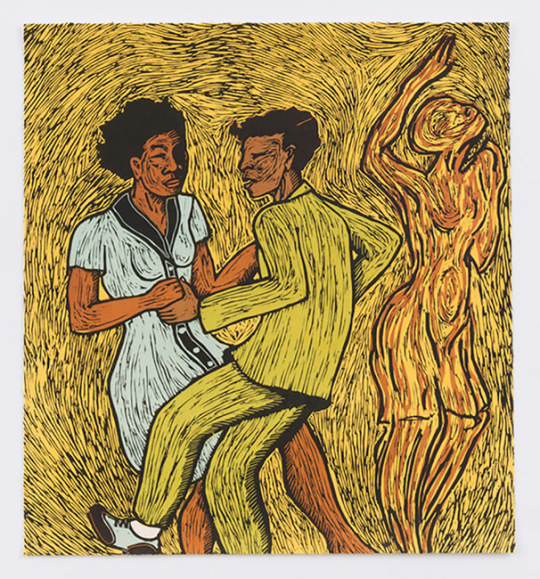



Prints by Alison Saar (b 1956)
“Alison Saar’s decades-long explorations of the African American experience as filtered through her personal symbolism connect to today’s essential conversations around racial reckoning and cultural belonging,” said Amy Gilman, director of the Chazen. “The museum believes this visionary work is crucial viewing for all of our diverse communities and audiences.”
Saar, who is based in Los Angeles, where she was born and raised, is known for her incisive sculptures, multimedia installations, and printmaking that reflect a broad range of creative influences, including ancient Greek and African forms and American folk art. In all of Saar’s wide-ranging work the artist has unflinchingly tackled complex personal and political subject matter with an eye towards accessibility and meaningful exchange.
https://www.artandobject.com/.../powerful-prints-alison...
26 notes
·
View notes
Text
Africa is a continent of more than 50 countries, and home to thousands of languages and cultures. Africans lived in complex societies, from small villages to large bustling cities, that contained universities, mosques, and libraries.
Africa has great civilizations that flourished in Africa included Egypt, Kush, Axum, Mali and Great Zimbabwe.
Africa's history is complex and stretches back through centuries of dynasties. Africa contributed to our knowledge and understanding of ancient writings, languages, agriculture and engineering. Its extensive trade system connected the continent with Asia and India, producing a lively exchange of goods such as grains, metals, and gold.
Black History instruction in K-12 education, 65% of the 401 educators interviewed said that their state does not mandate Black History instruction. Only 12 states require some form of Black history curriculum.
Africans were free before they were enslaved. Enslaved Africans relied on their knowledge and beliefs to survive slavery, and their contributions to U.S. culture, society, and economy are evident in every aspect of American life and enterprise. Agriculture, music, art, and culinary.
#history#african history#african american#education#Africa#axum#mali empire#great Zimbabwe#world history#public school#ancient
50 notes
·
View notes
Text

Kehinde Wiley - The Young Tarentine (Mamadou Gueye), after Alexandre Schoenewerk, 1871, 2021, bronze

Kehinde Wiley - Femme Piquée par un Serpent (Mamadou Gueye), 2022.
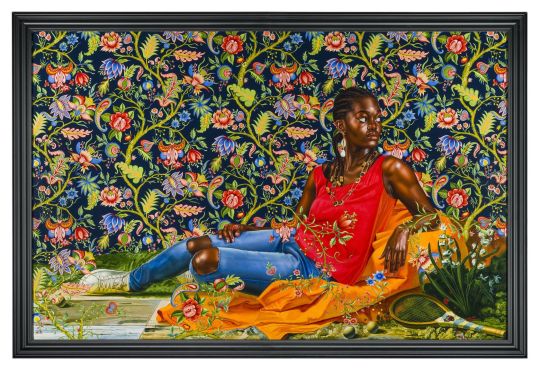
Kehinde Wiley - The Death of Hyacinth (Ndey Buri Mboup), 2022


Kehinde Wiley - "Morpheus (Ndeye Fatou Mbaye)", 2022.

Kehinde Wiley - An Archaeology of Silence
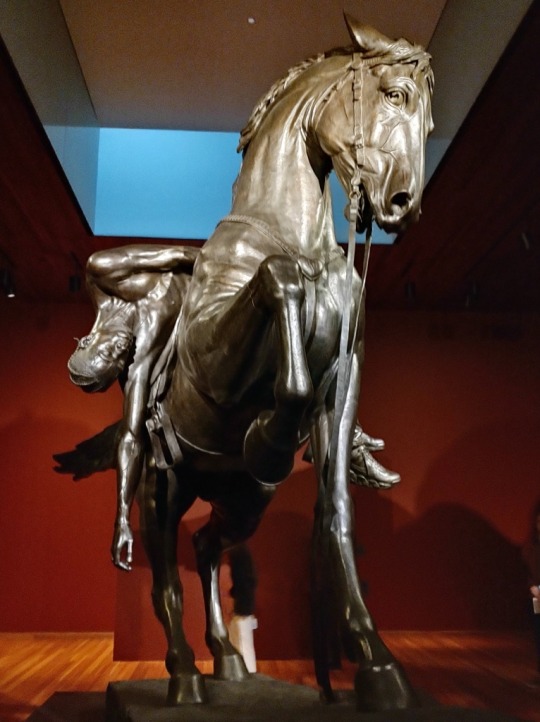

An Archaeology of Silence is the namesake of this piece, arguably the most breathtaking of the collection. For whiteness in general and white America specifically, the piece is a mirror, an entanglement of glory and suffering, discovery and erasure, settlement and displacement. For Indigenous and Black America it is a symbol of futures that allow us to look to the past to move forward. It is a relic of our origin story, an artifact of our epistemology, and where should it live if not in museums? Where else could our suffering be looked upon with honor and quiet reflection, with reverence and respect?

Kehinde Wiley - Ariadne Asleep on the Island of Naxos, 2021, after John Vanderlyn, 1825

John Vanderlyn - Ariadne Asleep on the Island of Naxos, 1825
Kehinde Wiley (b. 1977, Los Angeles) is an American artist best known for his portraits that render people of color in the traditional settings of European Old Master paintings. Wiley’s work brings art history face-to-face with contemporary culture, using the visual rhetoric of the heroic, the powerful, the majestic and the sublime to celebrate Black and Brown people the artist has met throughout the world. Working in the mediums of painting, sculpture, and video, Wiley’s portraits challenge and reorient art-historical narratives, awakening complex issues that many would prefer to remain muted.
n 2018, Wiley became the first African American artist to paint an official US presidential portrait for the Smithsonian National Portrait Gallery after former US president Barack Obama selected Wiley for this honor. In 2019 Wiley founded Black Rock Senegal, a multidisciplinary artist-in-residence program that invites artists from around the world to live and create work in Dakar, Senegal.

Kehinde Wiley
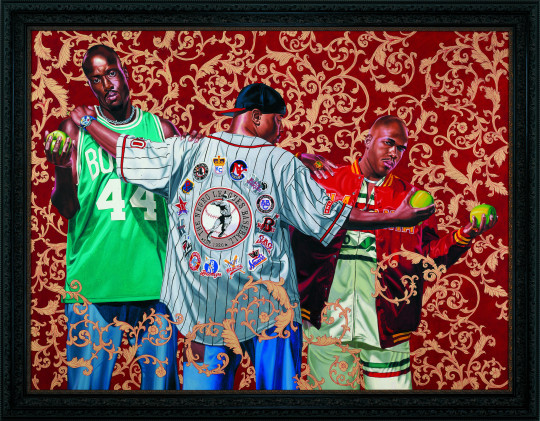
Kehinde Wiley - The Three Graces, 2005
#art#sculpture#paintings#kehinde wiley#Black Rock Senegal#Archaeology of Silence#morpheus#Death of Hyacinth#Mamadou Gueye#John Vanderlyn#barack obama#Ariadne Asleep#Ndeye Fatou Mbaye#Ndey Buri Mboup#artists#three graces
45 notes
·
View notes
Text
How to Create That Perfect Witch Character | A Guide You'll Need
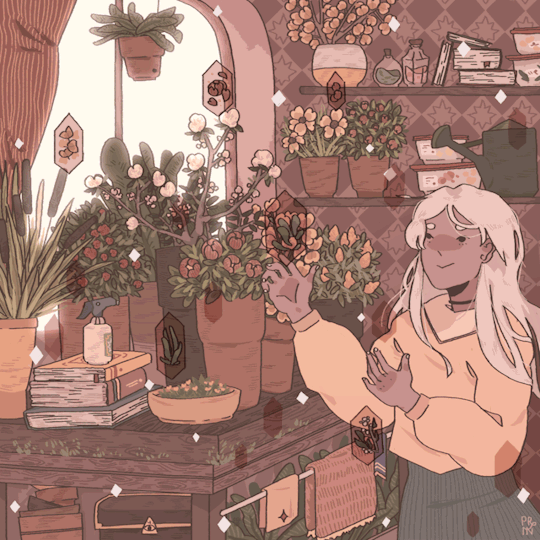
Introduction
Witches have captivated our imaginations for centuries, with their mystical powers and enigmatic presence. They are fascinating characters that bring a touch of magic and intrigue to any story. If you're an aspiring writer looking to create a compelling witch character, this article is for you. In this guide, I'll help you explore the different aspects of crafting a witch character that will captivate readers and leave them enchanted.
What is a Witch?
Before we delve into the intricacies of creating a witch character, let's first understand what a witch truly is. A witch is often portrayed as a person, usually female, who possesses supernatural powers and knowledge of arcane arts. These powers allow them to manipulate the forces of nature and harness magic for various purposes. Throughout history, witches have been depicted in different cultures and have played significant roles in folklore, mythology, and literature.
Different Types of Witches (Some of the many witches)
Witches come in various forms, each with their own unique attributes and abilities. Exploring the different types of witches allows you to add depth and richness to your character.
Here are a few examples:
Elemental Witches: These witches have a deep connection with the elements - earth, air, fire, and water. They can control and manipulate these forces to their advantage, using them for both offensive and defensive purposes.
Earth witches harness the power of plants and minerals, communicating with the earth itself.
Air witches excel in manipulating winds and manipulating atmospheric conditions.
Fire witches have an affinity for flames, using them to both destroy and create.
Water witches can bend the tides and command the waters, making them formidable opponents.
Witchcraft Traditions: Witches can also be associated with specific traditions or cultures, each with its own unique practices and beliefs.
Some examples include:
Traditional European witches who draw inspiration from folklore and ancient rituals.
African witch doctors who use their powers for healing and protection.
Hoodoo practitioners who combine elements of African, Native American, and European folk magic.
Witch-Hunters: In some stories, witches are pitted against a group of individuals known as witch-hunters. These characters possess knowledge and abilities to counteract witchcraft, creating a dynamic conflict within the narrative.
Why Write a Witch Character?
Now, you might wonder, why should you consider writing a witch character in the first place? Well, the answer lies in the endless possibilities they offer. By incorporating a witch character into your story, you inject a sense of wonder and enchantment. Witches bring an element of magic that can create tension, intrigue, and a touch of the supernatural. Additionally, witches can serve as powerful symbols of empowerment, representing individuals who break societal norms and embrace their own unique abilities.
How to Create a Compelling Witch Character
Crafting a compelling witch character involves careful consideration of multiple aspects. To create a well-rounded and captivating witch, pay attention to the following:
Appearance
A witch's appearance forms a crucial part of their character. Experiment with unique and unconventional descriptions to make your witch visually striking. Consider elements such as:
Unusual eye colors that hint at their magical abilities.
Intriguing tattoos or runes symbolizing their connection to ancient forces.
Clothing choices that reflect their personality or cultural background.
Personality
Beyond their appearance, a witch's personality should be equally captivating. Ensure your witch possesses a multidimensional character by incorporating traits such as:
A tendency towards mischief or a mischievous sense of humor.
An air of wisdom and ancient knowledge, gained from their connection to the supernatural.
Complex emotions and internal struggles, showcasing the human side of their magical existence.
Powers
The extent and variety of a witch's powers define their capabilities within the story. Consider incorporating different types of magic aligned with their character and backstory. Some examples include:
Divination: The ability to see the future or gain insight through various means, such as reading tea leaves or scrying.
Potion-making: Mastery in brewing concoctions with mystical properties, allowing them to heal or harm.
Elemental manipulation: The power to control and command the elements, shaping the world around them.
Backstory
A well-crafted backstory adds depth to your witch character. Delve into their origins and history to create a compelling narrative. Consider elements such as:
Mysterious circumstances surrounding their birth or discovery of their powers.
Significant events or mentors who shaped their magical abilities.
Personal tragedies or conflicts that molded their motivations and worldview.
Motivations
Understanding your witch character's motivations will guide their actions and decisions throughout the story. Some common motivators for witches include:
Seeking vengeance for past grievances or personal losses.
Protecting and preserving the balance between the natural and supernatural realms.
Uncovering ancient secrets or reclaiming lost knowledge.
Goals
Every captivating character has goals they strive to achieve. Your witch character should have clear objectives that propel the plot forward. Some examples of goals for witches could be:
Mastering a previously unattainable spell or magical technique.
Overthrowing an oppressive regime or exposing corruption within their magical community.
How to Avoid Common Witch Character Pitfalls
I had to make sure to add this important step for all your writers to note down.
While crafting a witch character, it's essential to avoid falling into common clichés or pitfalls. By steering clear of these stereotypes, your character will feel fresh and engaging. Be cautious of:
Making Them Too Evil or Too Good
Avoid creating one-dimensional witches who are either purely evil or overwhelmingly good. Add shades of gray to their morality and consider their reasoning behind their actions. This complexity will make them more relatable and intriguing.
Making Them Too Powerful or Too Weak
Finding the right balance of power is crucial. A witch who is invincible or all-powerful lacks vulnerability and can easily become dull. Conversely, a witch who is constantly helpless undermines the credibility of their powers. Strive for a believable power level that allows growth and challenges for your witch character.
Making Them Too Predictable or Too Boring
Predictability can diminish the impact of a witch character. Introduce unexpected twists and surprises that keep readers on their toes. Additionally, avoid making them one-dimensional or lacking depth. Explore their fears, hopes, and dreams to make them more relatable and dynamic.
Conclusion
Writing a captivating witch character requires careful planning and consideration. By focusing on their appearance, personality, powers, backstory, motivations, and goals, you can create a multi-faceted character that will enchant your readers. Avoiding common pitfalls and adding originality to your witch character's traits will make them stand out in any narrative. Embrace the magic and possibilities that come with crafting a witch character, and let your imagination take flight.
Tips for Writing a Great Witch Character
(An extra little something for my witch-fanatics)
Research various witchcraft traditions to add depth and authenticity to your character.
Read literature and watch films featuring witches to gain inspiration and insights.
Experiment with unique magical abilities and incorporate them seamlessly into your character's story.
Resources for Further Research
If you're looking to expand your understanding of witches and their portrayal, consider exploring the following resources:
Books on witchcraft and its history, such as "The Witch: A History of Fear, from Ancient Times to the Present" by Ronald Hutton.
Films and TV shows that feature witches, such as "Practical Magic," "The Craft," and "American Horror Story: Coven."
Websites and online forums dedicated to witchcraft and its various traditions, such as Witchvox or r/witchcraft on Reddit.
Now that you have the tools to create a captivating witch character, let your imagination soar and bring forth a magical being that will captivate readers and leave them spellbound. Happy writing! - Ren T.
Copyright © 2023 by Ren T.
TheWriteAdviceForWriters 2023
#writers#creative writing#writing#writing community#writers of tumblr#creative writers#writing inspiration#writeblr#writerblr#writing tips#writblr#writing prompt#story prompt#writing ideas#writing prompts#creative writing prompts#creative writing prompt#story idea#story ideas#writing idea#just write it#writers block#writer things#writers life#just writer things#let's write#writing resources#thewriteadviceforwriters#how to write#on writing
62 notes
·
View notes
Text

Today We Honor Emory Douglas
Born in 1943 in Grand Rapids, Michigan, Emory Douglas has been a resident of the Bay Area since 1951. He became the Minister of Culture for the Black Panther Party in 1967, a role he held until the party disbanded in the early 1980s. During the Party’s active years he served as the art director overseeing the design and layout of the Black Panther, the Party’s weekly newspaper. Douglas was trained as a commercial artist at City College of San Francisco and has been the subject of several solo exhibitions.
His work has also been in numerous exhibitions about the history of the Black Panther Party, including shows at the Arts & Culture Conference of the Black Panther Party in Atlanta, GA in 2008 and “The Black Panther Rank and File” at the Yerba Buena Center for the Arts, San Francisco in 2006. Most recently his work was the subject of a solo exhibition at Urbis, Manchester, UK in 2008-2009.
In 2007, artist Sam Durant curated a solo exhibition of Douglas’ work at the MOCA Pacific Design Center in Los Angeles, “Black Panther: The Revolutionary Art of Emory Douglas,” which is the inspiration for the presentation at the New Museum.
The same year, Rizzoli published a book with the same title that included essays and interviews about Douglas’s work and his relationship to the Black Panther Party. Douglas’s work has also been presented at the 2008 Biennale of Sydney, Australia; the African American Art & Cultural Complex, San Francisco; Richmond Art Center, CA; and the Station Museum of Contemporary Art, Houston. via gclass.org | CARTER™️ Magazine carter-mag.com #wherehistoryandhiphopmeet #historyandhiphop365 #carter #cartermagazine #emorydouglas #blackpanther #blackpantherparty #blackhistorymonth #blackhistory #history #staywoke
#carter magazine#carter#historyandhiphop365#wherehistoryandhiphopmeet#history#cartermagazine#today in history#staywoke#blackhistory#blackhistorymonth
47 notes
·
View notes
Text
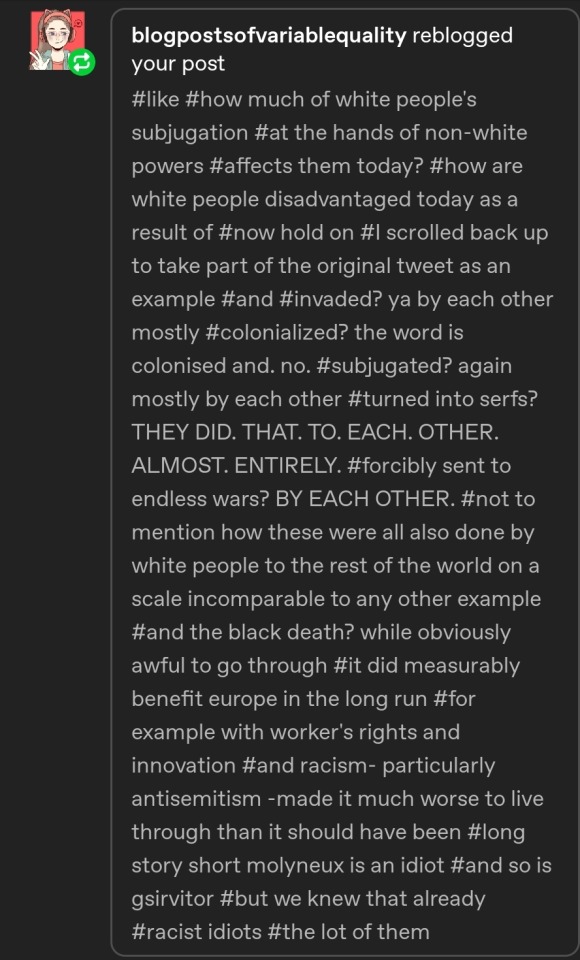
@blogpostsofvariablequality
How much does it affect them today? The same amount it affects non Europeans at the hands of Europeans, you can fill in the blank.
See, this is why I dislike the umbrella term of white people, sure it's an apt descriptor of a racial group, but it hides the nuance, the complexity of European history, culture and baggage.
The entirety of Eastern Europe has a multi thousand year history of being invaded by Asians and Middle Easterners, from the Turks, to the Huns, to the Ottomans, then there's the Greeks who have beef with the Turks and a history of Persian invasion, the entirety of Mediterranean Europe with the Barbary slave trade, the Mongol invasions, the black death, the Muslim conquests, etc etc, I can go on for hours, and that's not even bringing up the origins of the term Slave, which referred to a certain squating peoples now at war with eachother.
Every group is advantaged and disadvantaged by the modern world, especially in the west, for instance, a black man from Nigeria who moves to America is more often a higher earner than his American counterpart, why? Well it isn't disadvantages built into the system, it's the culture, for the Nigerian man his is a boon while the American's is a drag, why? One is built upon hard work, morals and looking to the future, while the other is dead set on looking at the past and wallowing in it, blaming all failures, not on one's self but on a nebulous bogeyman, the same way the Nazis blamed the Jews.
The same goes for any race, Europeans are outcompeted in their own nations by Asians and Indians, not because they're actually at any disadvantage other than what is self imposed, and that's the crux, those who screech about being perpetually disadvantaged by the "white" man, never work to improve themselves, to create a better future for their descendants, no, they just whine and beg for free handouts, as the Greeks say; "A society grows great when old men plant trees whose shade they know they shall never sit in."
Your statements mean very little, yes, the world is colonized, it has been colonized since time immemorial, over and over and over again, yes, Europeans did that to themselves, and others did it to them, just as Africans, Asians, Middle Easterners, etc have all done it to themselves and others since time immemorial, same goes for subjugation, slavery, etc.
And no, European colonization, when compared to the conquests of the past, were some of the least violent conquests in history, sure the land area claimed is incomparable, but the savagery, the brutality etc, pales in comparison to even just the Mongols and Huns.
Yes, the plague brought many benefits, such as modern labor movements, improvements in medicine and a new approach to life, much of the Italian Renaissance, even Shakespeare's drama to some extent, is an aftershock of the Black Death. Today its effects can be seen in the resistance to AIDS seen in some European populations.
However, the black death was only a benefit to the descendants of those who survived one of the darkest pages in European history, its consequences were profound. Besides the immeasurable pain and grief, traditional Medieval society was thrown into chaos and turmoil, economies were fractured, the Church lost status, and art and literature took a turn for the gruesome and bizarre, and Europe lost 30-60% of its population.
Ah yes, racism and antisemitism, something about this post has made people act quite racist, from calling for the subjugation of the white race, to comparing me, someone of Jewish descent, to the Nazis, this post has been a magnet for the mentally compromised.
However, I don't expect any critical thinking skills from, as you put it, racist idiots, so I say again, I don't care about the suffering of your ancestors, for you don't care about mine.
Good Day.
73 notes
·
View notes
Text
The Black Woman is God - Wikipedia
The Black Woman Is God is a recurring group exhibition of Black women artists curated by Karen Seneferu and Melorra Green, which started in 2013 and in 2016 and 2017 has been located at the San Francisco city-owned nonprofit art space SOMArts. The exhibitions challenge a popular western mindset of God as a white male and instead explores new images showing "The Black Woman is God".
2013 Exhibition at the African American Art & Culture Complex edit
The first iteration of The Black Woman is God was intended as a solo exhibition for Seneferu, curated by Green, at the African American Art & Culture Complex. Seneferu agreed to participate in the exhibition only if other black female artists were included.[1] The exhibition included 20 visual and performance artists. The opening reception also included a performing arts show as part of the exhibition and was called "vibrant and magnificent".[2][3][4]
2014 Exhibition
The 2014 exhibition was held at the San Francisco Public Library in the African American Center from March 1 to May 15, 2014.[5]
2016 Exhibition
The next expanded exhibition, The Black Woman is God: Reprogramming that God Code, opened with 60 artists on July 7, 2016, and ran through August 17, 2016 at SOMArts.[6]
Art critics called it as "timely", "organic",[7] and "vivid".[8] Sheila Bapat of Bitch wrote "The exhibit intentionally turns the historic devaluation of Black women and their contributions—social, political, economical—on its head. This exhibit asserts Black women’s power and beauty and does not seek to devalue any other group in the process..... It applies pressure to the beliefs and values undergirding the laws and policies that exclude Black women’s lives from economic policymaking and their labor from economic value and protection."[9]
2017 Exhibition
The next exhibition, The Black Woman is God: Divine Revolution, also curated by Karen Seneferu and Melorra Green, returned to SOMArts on July 20, 2017, and ran through August 26, 2017. The exhibition had the work of 80 artists on view.[10][11] SOMArts, the California Digital Library and Art Practical held a Wikipedia Edit-a-Thon on July 22 in conjunction with the exhibition "to raise the online visibility of Black women artists and challenge the gaps in art history that erase or minimize Black women’s contributions as artists, activists and social change-makers."[12]
7 notes
·
View notes
Text
A LITERARY MASTERPIECE : DISCOVERING NEVER TO LOVE AGAIN

A unique story which transcends between friendship, love, hope and uncertainties that accompany the journey of an average Nigerian girl and her struggle to keep her commitment to the love of her life. This literal work of art, written and published in 2004 by American based Nigerian author Ngozi Onyegbule has its setting in two very contrasting places : A small intimate town in the Eastern Nigeria , and United States of America. In this novel of 18 chapters, Onyegbule, was able to deliver an African fiction in English, that promotes the culture and tradition of Nigeria just like some remarkable diaspora Nigerian based authors; the likes of Buchi Emecheta and a few others. As its name depicts , this is a story of a vow made from experiencing the rough side of westernization.

SUMMARY
Never to Love Again is a fictional story that centers on a young beautiful girl by name SYBIL AFOR, who falls in love with a promising young teacher KENNETH NKWO. Sybil, the last child of her strict and disciplined parents, gets into a committed relationship with Kenneth: the handsome, sweet and caring part time soap supplier of her mother.
These two characters go through several phases to keep their relationship glued in hope to get married someday. Their many years of friendship and commitment is thrown into new and complex trials which comes with Sybil’s move to further her study abroad. Though a struggling and underpaid young teacher, Kenneth quiets his plans to study law abroad, and channels his finances and energy, to complete the traditional marriage rites for his soon-to-be bride, and also reward her with a rich send-off party.
Sybil arrives the western soil, and is faced with pressure from her sister, college roommate, and the environment around her to follow the path she has ventured into: coming to America, and forget about the old path : Kenneth and their commitment. After much thinking and deliberation, Sybil drops the bombshell of breakup on Kenneth by letter, who receives it with shock and horror. Karma strikes the face of Sybil as she is asked to leave her school and the country after she was found ineligible to matriculate. Meanwhile on the other side of the world, Kenneth prepares to leave his home country, to study law. This leaves a heartbroken and deported Sybil in regret. But alas! a ray of hope appears for their relationship as Sybil receives admission from another school to start over again. Though the novel ended in a declined mood, there seems to be a sunrise to their relationship in the sequel “LOVE FORGIVES ALL SINS”
THEME: The novel has various themes laced in it, which would be of great interest to diverse readers. Some dominant themes are : Love, Peer-pressure, Doggedness, Respect, Cultural practices. And some sub-themes like : Independency, Friendship, Discipline, Courage, Fear, Early Detection can also been found. With makes it a jungle of many emotions and thoughts.
SETTING: Employing different places and cultures, the general setting of the novel is the late 20th and early 21st century. The movement of the characters also juggle from the western setting to the Nigerian setting.
PLOT: The plot, which is very much arranged and beautifully intertwined, graduates into the themes, characters and setting. So it’s safe to say that the plot is well planned.

ANALYSIS
CHARACTER DEVELOPMENT: The rise and use of each character, shows that the author, carefully thought of each one, and their role-play before infusing them to the plot. The main/ round characters which are Sybil, and Kenneth,touched every aspect of their role with precise and accurate details. There are some stoic and flat characters who played their role perfectly without absorbing change like : Victoria Sybil’s sister, Rosario Perez, Anthony, Bethrand and host of others.
LANGUAGE AND WRITING STYLE : The author employs the use of Narrative and Descriptive style to tell this story. The use of figure of speech is also dominant, and it can be seen is some examples like :
“one hundred feet long” ( line 3,page 124) which is used to describe the veil of a bride.
“All hands were on deck” (line 2,page 122)
“Marching to the altar” ( line line 5,page 119)
“Small lord” ( page 101) .
The author also makes use of the Omniscient point of view style to illustrate the various aspects of the book.
STRENGTHS: The greatest strength of Never too Love Again, is its accuracy and powerful illustrations of the people’s cultural practices, the different ways people see or accept the cultural practice amongst them. The fact that a lot of people would be able to relate to this story because of its authenticity and it vibe, is a major strength of this book.
When you line the background and personality of the author with his fictional work of art, you would see that the author has had ample experience of both cultures, so it’s safe to say he knows what he is writing about.
WEAKNESS: The dominant weakness of this book, it’s in its typesetting. The absence of quotation marks in this book, is what makes it weak. This makes it harder for readers to differentiate between the characters speech from normal writing. This is a major weakness because it would take a longer process to read and accumulate.
IMPACT: Never to love again, has recorded significant progress and awards in United States, due to the diasporic nature of the author. But discoveries that are about to be made about this novel, would soon throw it into National archives and collections.

CONCLUSION
My dear book readers and lovers, you just have to add “Never to Love Again” to your TR ( To Read ) list, because a journey through the cultural display and the rollercoaster emotions in this novel, is worth every glance. Remember, be patient and make sure you savor each chapters essence.
I wish you a lovely read,
@omalichathewriter

5 notes
·
View notes
Note
Sadly, Cleopatra isn’t the only one, they did it with Anne Boleyn, Charles V, Marie-Antoinette, China and Japan’s indigenous people. I mean, they still think that Caucasian means white.
I don’t understand why they refuse to explore or portray West Africa, East Africa, or Sub-Saharan Africa, its people, mythologies, religions. It has countless ethnic nationalities, and very rich and diverse cultures.
My theory is that it is because of two reasons:
This is an African American thing. Secondarily, similar ideas might be supported by next generation immigrants in West Europe at most. I find it wrong that it is called “Afrocentrism” because that trend does not represent indigenous people of Africa, or indigenous people in general, their concerns or their wishes. If you check videos about the whole Cleopatra discourse, Africans do not support the case, they feel weird about it and even embarrassed by the way African Americans tackle these topics. African Americans do not fight for Africa. They fight for their own place in the American society and because they have an extremely traumatic past imposed on them by the American whites, they see this movement in a peaceful yet clearly vengeful perspective. African Americans try to claim more space in societies that were traditionally considered white or colonialist. They do not care nowhere as much about empowering or boosting the voice and development of African countries as at this point they feel distant from them. They too are Americans now, after all. The ulterior incentive is not to present, praise and attract interest for African or other POC culture but rather to be seen as capable of competing with or even toppling white history and culture. Unfortunately, this very ill thought strategy is applied to feminism too. Instead of presenting women as complex people with their strengths, ideas, aspirations and motives, they force them always to a comparison with men or they have to aggressively belittle men and have women assume their positions (ie the James Bond discourse). That’s why the first Wonder Woman movie was so acclaimed and successful in its feminism with both women and men - it was an original female character who also worked peacefully with men. Unfortunately they don’t seem to take the hint of WW for what works and what doesn’t. And to go back to the original topic, this is why Black Panther is also much more acclaimed and successful than all those idiotic projects twisting history to a laughable degree. But these are superheroes and, therefore, also parts of the American culture. To ask Americans to go deep in studying African and Asian cultures and produce accurate and sensitive art from them is too much work and it is not even what they want to talk about anyway.
95% of these movies are made or produced by rich whites. Rich whites follow the trends of the time with zero interest in historical accuracy or sensitivity about other places in the world. A rich white American producer does not care how well his movie will be received in Tanzania or Yemen. He cares how many African or Asian Americans will go to the cinemas. This is the audience they cater to, plus white wokes which is another big trend that can provide his movie with a lot of traction. Neither Africa nor Asia nor indigenous communities in the Americas and Oceania have a remotely considerable benefit out of any of these. Nothing will change in Kenya or in Kenyan people’s everyday lives, concerns and challenges just because Anne Boleyn is now black. It’s been called USA and West Europe’s guilt syndrome but I think it is mostly the realisation that a pretence of a guilt syndrome pays well in these countries’ media production because some people in these countries suck it up like crazy.
16 notes
·
View notes
Text
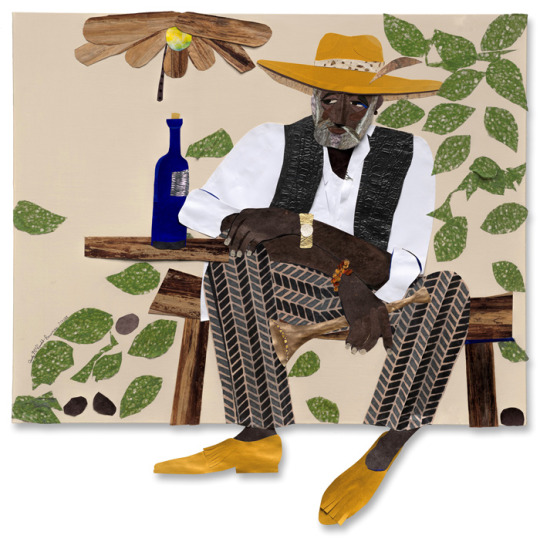
COLLAGE ON VIEW
Gratiot Griot
Judy Bowman at the Museum of Contemporary Art Detroit through 26 March 2023. “Gratiot Griot” is the first solo museum exhibition of mixed media collage artist Judy Bowman. This exhibition presents new works alongside older collages by the artist that invite viewers to engage with the rich cultural tapestry of life across the African diaspora. Bowman creates visual works inspired by stories of African American life. Collaged images depict and highlight the intimate landscape of neighborhoods, homes and gathering places that encouraged Bowman’s development as a griot. In West African tradition, a griot is a storyteller who, through creative performance, preserves and shares the cultural legacy and histories of their people. “Gratiot Griot” highlights Bowman’s extensive career as a storyteller. MORE
*****************************
Kolaj Magazine, a full color, print magazine, exists to show how the world of collage is rich, layered, and thick with complexity. By remixing history and culture, collage artists forge new thinking. To understand collage is to reshape one's thinking of art history and redefine the canon of visual culture that informs the present.
SUBSCRIBE | CURRENT ISSUE | GET A COPY
SIGN UP TO GET EMAILS
#collage#collage art#collage artist#art#artist#art history#artists#art project#art show#art books#art education#book art#contemporary art#artwork#modern art#fine art#artist residency#contemporary artist#artist portfolio#artist book#artist profile
13 notes
·
View notes
Text

⚠️ As usual, long post. ⚠️
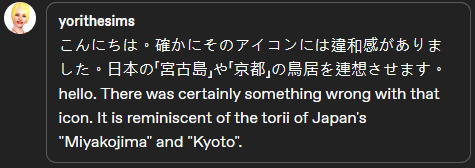
Thank you very much for your input @yorithesims.
Somebody whose country’s building icon wrongly used - from Japan - for Shang Simla world, has spoken.
This is reply from post somebody asking about traditional Chinese clothing and continuation from “EA Misinterpretation of China and Chinese Culture in Shang Simla world.”
I did research about San Francisco, California. It has big Asian population in USA country. Chinese has big percentage 19,8% from total Asian population 33,1%. Source WIKI.
As for the 2010 census, the ethnic makeup and population of San Francisco included: 390,387 Whites (48.1%), 267,915 Asians (33.3%), 48,870 African Americans (6.1%), 4,024 Native Americans (0.5%), 3,359 Pacific Islanders (0.4%), 53,021 from other races (6.6%), and 37,659 from two or more races (4.7%). There were 121,744 Hispanics or Latinos of any race (15.1%).

The Sims 3 studio that created The Sims 3 World Adventures located at EA’s Redwood City campus, San Francisco, California.
Second biggest Chinatown is in San Francisco. Quite near from The Sims 3 studio is located. 51 minutes by car.

Then explain why The Sims 3 World Adventures team cannot represent Chinese culture at all for Shang Simla world when the studio location is near big Chinatown and the state has big Asian population, especially Chinese?
The year was 2009, there were fast internet connection, line telephone, magazine, encyclopedia. The Sims 3 was first being published then started to create new project World Adventures Expansion Pack. There must be Chinese descent working at The Sims studio, it is logically Asians - especially Chinese - living in Western country working for big corporation. Then why were the designer team not willing to spend one minute to ask to their Chinese descent co-worker? Not willing to ask actual Chinese people on the street, Chinatown, make invitation for interview in corporation, with EA’s gift & merchandise as return, at all?
As 3D Designer staff myself who used for work in mobile game studio, I’m sure one of designers and programmers (who coded the game) must be Chinese descent. 3D Designer sit close together with programmers division, as they must send the work quickly to programmers to be coded, then got feedback if there’s something wrong to get fixed quickly. Why nobody checked the inaccuracies, “Hey, we’re Chinese people do not bow like Korean or Japanese”, “There is no such thing as Fortune Cookies in China”, and definitely “The country icon is very wrong, that is Japanese Torii Gate not Chinese Gate? Have you ever went to Chinatown? Chinese gate is supposed to look like this:”

That is Chinatown’s Chinese gate located in San Francisco. 51 minutes drive by car from EA’s The Sims studio.
That is merely Chinatown, which the gate is very simple and not resembling complexity of actual Chinese gate from China. Chinese gate in actual China look like these:

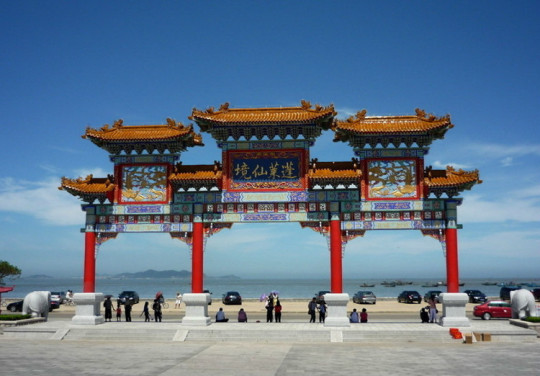
EA had created Chinese Gate at Forbidden City area.

Japan is very popular destination country desired by many people worldwide. Westerners must be willing to travel to Japan compared to China. If somebody had been travelled to Japan, they must be knew that this gate is from J A P A N.

The first thing to do when to design something is asking for reference right.
How could many employees in studio didn’t know the difference between Japanese and Chinese gate. The 3D designer had already made Chinese gate in the game! Surprisingly, I did research at Sims 3 World Adventures credit and it has:
https://www.mobygames.com/game/windows/sims-3-world-adventures/credits
many Chinese descent working at studio working in Art Team and there’s Japanese name on the credit.
My god.
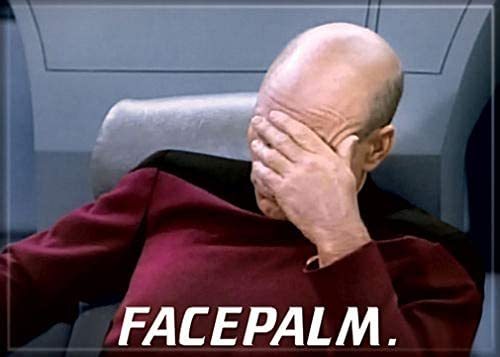
The designer team made the building like Forbidden City, Great Wall, Temple of Heaven, Chinese gate right and appropriate for game (low-poly & modular & have great textures),
Soundtrack music used for Shang Simla are accurate because EA bought the music stocks from actual Chinese music. I had heard one in supermarket in my hometown city, played when I was shopping for Chinese New Year’s Eve.
Then the rest of elements are just... meh. Wrong and stereotypical.

Upper management must be know if the game sold internationally in the actual countries as portrayed in the game, they should prepared Research & Development. EA as big video game developer clearly has big budget, resources, headquarters in Shanghai, it’s clearly very easy for them to do survey to real Chinese people in China country by asking their own employees working in Shanghai headquarters!
My workplace is very multicultural and multi-religion. It’s common and usual for designer in my team for asking to the person who practices the religion or specific race embraces the culture for reference. Non-Chinese designer asked to me is it right to use fireworks to design Chinese New Year? I said no, because fireworks are not used for Chinese New Year. Fireworks are for regular New Year. Traditionally Chinese New Year uses firecrackers. I supervised my juniors for not wrongly representing the design such as do not use white colour for Chinese New Year because white colour is to represent sorrow for the death.
Reply to @murfeelee I do empathize with your situation regarding race/ethnicity portrayed in-game. I had heard Black simmers protested about how awful the skintones and hair based on cauliflower in Sims 4. It was very bad. Sorry about that too. There must be Black / African descent in studio, but somehow they cannot make the content right at all. Just look how bad and stereotypical the portrayal of Shang Simla despite the studio has Chinese descent, surrounded by Chinese population in San Fransisco and EA has headquarters in Shanghai, China. The Sims is AAA title made by big budget corporation, they seem reluctant to hire or consult specialist expert in the area regarding race/ethnicity at all, despite they had earned a lot of revenue from Sims 1,2,3,4.
I have no words towards TS4 Snowy Escape. Better Japanese Simmers themselves to judge whether the portrayal is right or wrong.
I had read simmer from Hong Kong complained about Shang Simla inaccuracies in Sims 3 forum. Had heard somebody in Youtube complained about wrong icon Japanese Gate used for Shang Simla. Not just me.
Who are the clients of video games? None, just customers who throw money at developers. Video game developers can create any concepts of game anything they want, they can release their game whenever they want, but the problem is the investor or any upper management wants to sell the game as fast as possible because classic reasoning of “production cost“ of the game.
TS3 World Adventure has big and ambitious title with 3 different countries, it should be postponed to last order of expansion pack rather than first, as it is obviously needs more time to develop.
Another information for non Chinese simmers:
@pitheinfinite Glad to see you came back again. You can jump in and comment to add more information, because I might have missed something:
Queue hairstyle from Qing dynasty.
This is not just ugly hair. This is forced hairstyle by Manchus because China was ruled by Manchus in Qing dynasty. Which is not original Chinese hairstyle. Bold in front, then pulled with braids. Refusing this hairstyle would be punished with death (beheaded) by law stated by Manchu emperor. My real life great-great-great grandfathers before migrating to my country now were from Qing dynasty with this kind of ugly hairstyle. It’s very insensitive for EA to release this kind of hair, as it is bad ugly stereotype and reminds of bad past when China was ruled by Manchus. May mislead international people as if China and Chinese people still has this kind of hairstyle in modern times.
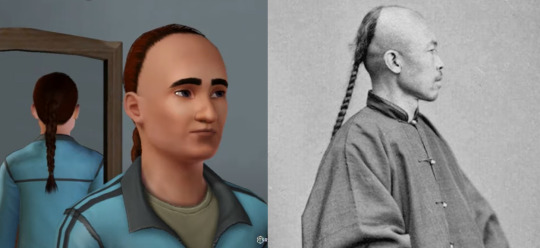
In-game Sims, the Tourist NPCs keep appearing with random clothing and hairstyle including this kind of hairstyle. As ethnically Chinese myself, I do not want to see this kind of hairstyle, ugly and oppression to invader with beheaded as penalty. Not funny. Furthermore, Shang Simla is supposed to take place in modern but in village. This ancient hairstyle is supposed to not exist in Shang Simla.
EA designer team seemed to forcing themselves making local hair for each country including France and Egypt, which are... stereotypical. Hate to say this but Americans apparently only know Queue hairstyle as Chinese hairstyle, which kind of hairstyle when Chinese immigrant first came to USA country. If only the team do some research and survey to actual Chinese people... Shang Simla local male Sims should have hairstyles like these.
*Ladies, please focus on the hairstyles*
More reusable modern short hairstyles. Champs Les Sims have modern hairstyles too, not ancient Medieval.

And for ancient hairstyle it should be long hair before Qing Dynasty Manchu oppression came in.

which all of them can be added as CC hair made by CC creators.
Scary dragon cave
The dragon cave with red eyes portray as if Chinese dragon is scary monster beast. With this kind of image, international non-Chinese people who don’t know Chinese culture will see Chinese dragon as beast monster like Western dragon.
Chinese dragons are gods who control rain, weather, and seasons. Not comparable with Western dragon which is evil reptile beast who throws fire from mouth. Chinese dragons are kind, benevolent, powerful, who bring luck and prosperous. In Chinese New Year there is Dragon Dance as symbol for good luck.


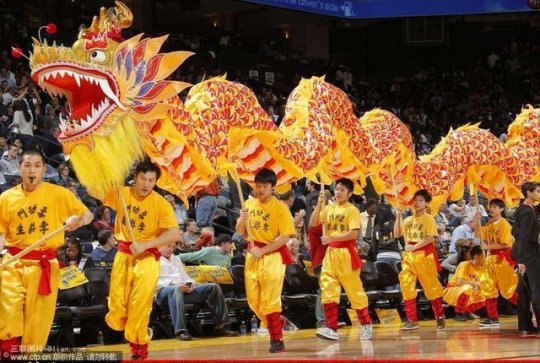
Unrecognizable “Chinese” something random clutter.
@pitheinfinite Do you know what item is this? I can’t recognize at all.
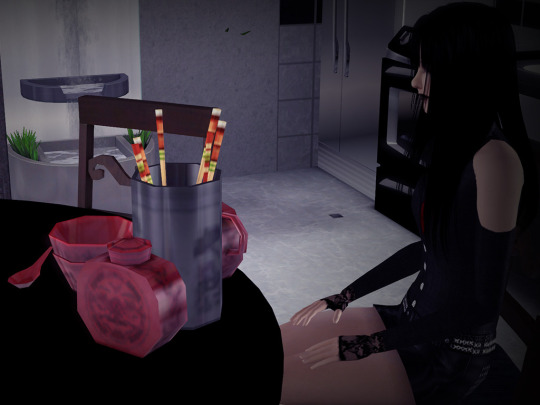
If those are chopsticks, they are very big, as big as and look similar to Chinese incense burning sticks. Very inappropriate to put Chinese incense burning sticks - which is to pray - in eating utensils on kitchen table. Yes, I know those are kitchen utensils with chopsticks but EA employees forgot to resize, maybe because struggled with tight deadlines.
Chinese burning incense:
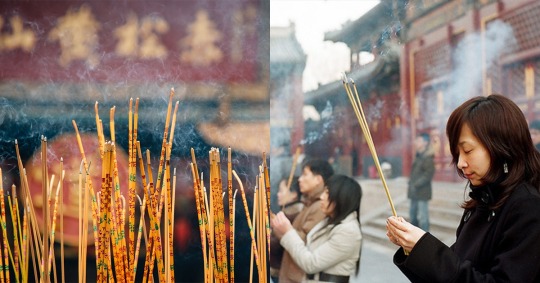
Shang Simla is not based on any real China province. It’s just random *plop* of specific iconic buildings to *plop* random green forest.

The mountain forest is not Guilin. Very far from that. It’s like EA wanted to imitate Guilin’s high and sharp mountain but failed miserably, so it looks like ordinary mountain hills.

Forbidden City, Great Wall, Chinese Gate, Temple of Heaven are in fact in Beijing, China. But the rest of the forest surrounded is just random forest. The real Beijing is all city. Shanghai is all full city. Do not believe if there is Westerner / non-chinese international person says Shang Simla is based on Beijing or Shanghai or Guilin. That is wrong and bullshit. 😂
Beijing city, where the Forbidden City located: https://www.sohu.com/a/414882678_118889

EA Shanghai headquarters

List of games made by EA Shanghai, China. :
FIFA 21, Star Wars:Squadrons, NFS: Heat, Battlefield V, Star Wars: Battlefront II, Need for Speed: Payback, FIFA 18,
Battlefield 1, Plants vs. Zombies: GW2, Need for Speed,
Battlefield: Hardline, Sims 4, The Plants vs. Zombies: Garden Warfare, Need for Speed: Rivals, Dungeon Keeper,
Army of Two: The Devil's Cartel, Dead Space 3, Medal of Honor: Warfighter, Flower Daze, Army of Two: The 40th Day,
Sims 3, The(2009) Godfather II, The, Mirror's Edge,
Sock Hop Slots, Dead Space
#the sims 3#the sims 3 world adventures#ts3#shang simla#san fransisco#chinese culture#chinese gate#forbidden city#beijing#china#electronic arts#shanghai#chinese dragon#video games#the sims#asian culture#模擬市民3#qing dynasty#chinese hairstyles#queue hairstyle#guilin#桂林#北京#上海#中國#中國文化#chinese burning incense#燒香
30 notes
·
View notes
Text
The Black Woman As God
youtube
The Black Woman as God is a concept that has been explored in art, literature, and religion for centuries. The idea of the Black Woman as God is often seen as a way to empower Black women and to challenge the dominant white supremacist narrative.
There are many different ways to interpret the concept of the Black Woman as God. Some people see it as a literal interpretation, meaning that they believe that Black women are literally God. Others see it as a more metaphorical interpretation, meaning that they believe that Black women embody the divine feminine. Still others see it as a combination of both literal and metaphorical interpretations.
There is no one right way to interpret the concept of the Black Woman as God. It is a complex and multifaceted concept that can be interpreted in many different ways. However, all interpretations of the concept share a common goal: to empower Black women and to challenge the dominant white supremacist narrative.
The concept of the Black Woman as God has a long and rich history. It can be traced back to the ancient world, when Black women were often worshipped as goddesses. In many African cultures, for example, the Earth Mother was worshipped as a Black woman. The Earth Mother was seen as the source of all life, and she was revered for her fertility and her ability to give birth.
The concept of the Black Woman as God also has a strong presence in the Bible. In the book of Exodus, for example, Moses is led to the Promised Land by a Black woman named Miriam. Miriam is a powerful and prophetic figure, and she is often seen as a symbol of the Black Woman as God.
In the New Testament, the Virgin Mary is often seen as a symbol of the Black Woman as God. Mary is a Black woman who gives birth to Jesus, the Son of God. She is seen as a symbol of love, compassion, and strength.
The concept of the Black Woman as God is also present in African American literature and art. In the novel Their Eyes Were Watching God, for example, Zora Neale Hurston writes about a Black woman named Janie Crawford who is on a journey to find her true self. Janie eventually comes to realize that she is a goddess, and she embraces her power and her divinity.
The concept of the Black Woman as God is also present in the work of many Black artists. For example, the artist Faith Ringgold has created a series of paintings called "The Black Madonna." These paintings depict Black women as Madonnas, and they challenge the traditional image of the Madonna as a white woman.
The concept of the Black Woman as God is a powerful and empowering concept. It is a concept that can help Black women to see themselves as divine and to claim their power. It is a concept that can help to challenge the dominant white supremacist narrative and to create a more just and equitable world.
youtube
7 notes
·
View notes
Text
the art historical canon is clearly founded upon western/european narratives, and this bias has always been abundantly clear throughout my education in the discipline. it manifests itself in academic texts or museum exhibitions which indiscriminately lump together african, oceanic, asian, and indigenous american art despite these works originating from wildly different cultures, contexts, and time periods; through the flippant recognition of "primitive" art as it relates to european modernist sensibilities; when entry-level art history classes discuss european theft of foreign artifacts through the lens of a colonial savior complex as opposed to the cultural genocide it actually is. we discuss the missing relief sculptures of the parthenon not as left but as part of the patronizing Elgin Marble narrative: we are saving these historically significant works from the turmoil of the global south! in reality we are re-writing the cultural histories of these important and significant civilizations. we are disrespecting their histories and customs and the people which built those from the ground up. this theft and western/colonial re-contextualization, this purposeful reframing of the canon to favor european conventions and sensibilities goes so much deeper than even the most woke art history program will dare to delve into.
#just learning about how fucked up the acquisition and decontextualization of the benin bronzes is#like damn we never got into THAT shit in AP art history#my senior seminars def picked these issues of art history canon & western bias & colonialism a little more#but we never truly got into how fucked up it is to not only seize these artifacts but!!!#how in doing so we divorce them from their historical context and consequently rewrite the historical narrative of these cultures etc etc
3 notes
·
View notes